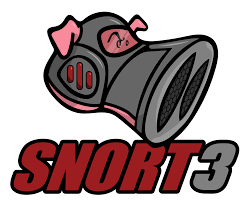Snort 3 — Open-Source IDS/IPS Engine
Why It Matters
Snort has been one of the best-known intrusion detection systems for two decades. The third generation (Snort 3) is more than just an update — it’s a redesign aimed at speed and flexibility. Many admins still run Suricata or Snort 2, but Snort 3 brings better performance, Lua-based configuration, and modern packet processing. For teams that want a proven IDS/IPS engine with Cisco support behind it, Snort 3 is a logical step forward.
How It Works
Snort 3 is a packet inspection engine. Traffic is fed into Snort (via a tap, span port, or inline setup), where it’s decoded, normalized, and matched against rule sets. Rules define patterns for attacks — from buffer overflows to malware callbacks. Snort 3 adds a modular architecture: detection engines, preprocessors, and output modules can be extended or replaced. Policies and tuning are handled with Lua scripts, which is far easier than the old config style. In IPS mode, Snort can block packets directly, not just alert.
Technical Profile
| Aspect | Details |
| Platform | Linux, BSD, Windows (less common) |
| Function | Intrusion Detection/Prevention (IDS/IPS) |
| Rule system | Community and subscription rulesets, Lua-based config |
| Performance | Multi-threaded, optimized packet processing |
| Deployment modes | Inline IPS, passive IDS |
| License | Open source (GPL), with Cisco commercial support |
Deployment Notes
1. Install from source or packages (available for major Linux distros).
2. Configure interfaces for sniffing or inline mode.
3. Load community or paid Cisco Talos rulesets.
4. Write or edit Lua configs for tuning and policies.
5. Monitor logs or forward alerts into SIEM/SOC platforms.
Where It Fits
– Enterprises wanting a Cisco-backed IDS/IPS.
– SOC environments feeding Snort alerts into SIEM for correlation.
– Research labs testing signatures and packet behavior.
– ISPs or hosting deploying inline packet filtering.
Caveats
– Configuration requires learning Lua — simpler than old syntax, but still a shift.
– Performance depends on tuning; defaults can be noisy.
– Competes with Suricata, which some admins prefer for multi-threading and easier scaling.
– Community rulesets are free, but best detection comes with Cisco’s subscription feed.

